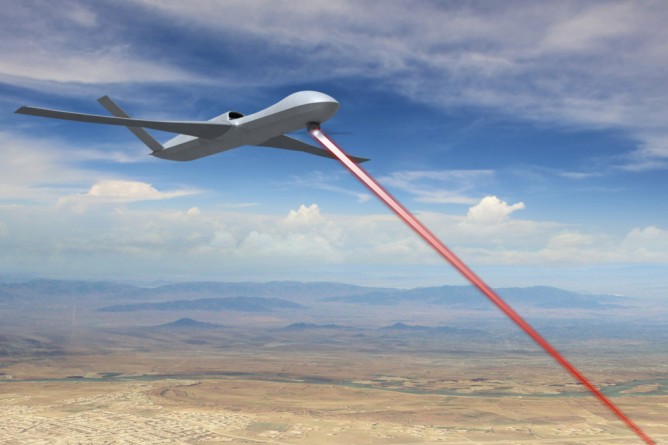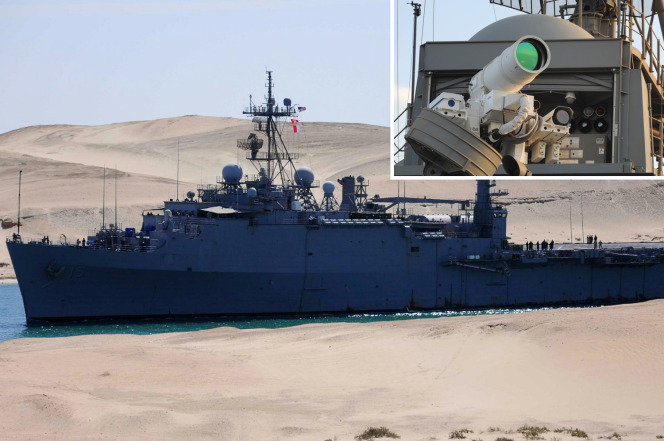
This month, the Force awakens in theaters. Next month, a new force awakens in the New Mexico desert, where the Defense Department is to start testing a weapon worthy of “Star Wars” — a silent, invisible laser that needs just a couple of seconds to burn a hole in targets miles away.
“What it really boils down to is a silent weapon that nobody sees or hears,” said Lt. Gen. Bradley Heithold, commander of Air Force Special Operations Command (AFSOC, pronounced “AFF-sock”).
Heithold is eager to put a laser cannon on four or five of AFSOC’s three dozen or so AC-130 gunships. AC-130s are typically used to cover special operations troops on nighttime missions.

“I think we can do this now,” Heithold said of the laser weapon. “When I say now, I’m talking about by the close of the decade.”
If Heithold is right, that’s a revolutionary turn of events — after decades of costly research.
A laser — the word is an acronym meaning “light amplification by stimulated emission of radiation” — is an intense beam of light that can be produced using a variety of materials. Bursts of energy are “pumped” into a “gain medium,” which can be a gas, liquid or solid, to excite the gain medium’s electrons and release photons.
Low-power lasers are a major part of modern life, using helium and neon gas to generate harmless light beams that do everything from scanning bar codes to changing TV channels to providing lecturers with handy pointers.
Higher-power lasers are used for everything from eye surgery to drilling precision holes in diamonds and steel, and those can damage a person’s eyesight or cause other injury.
But while visions of lasers powerful enough to kill people or knock aircraft out of the sky or sink boats have been a staple of sci-fi since “Star Wars” was just a gleam in George Lucas’s eye, laser cannons are only now on the verge of becoming reality.
In the 1990s and early 2000s, the Defense Department spent billions of dollars experimenting with laser weapons that relied on gases or liquids to generate extremely powerful beams.
The Air Force tested airborne chemical lasers by installing them in both a C-130 cargo plane and a 747 passenger jet. But those lasers were large, heavy, ghastly expensive and required the aircraft to return to base after only a few shots to refuel the chemicals.
“Laser weapon systems have been demonstrated a number of times. It’s just that none of them have really made the step of going into operation in the field,” said Mark Kramer, the Air Force manager for the upcoming New Mexico tests.
A 1999 Pentagon review concluded that chemical lasers were impractical as weapons, leading academics and the industry to shift their attention to “electrically pumped” solid-state lasers of two kinds: “bulk” and “fiber.” Both types generate their beam by sending electricity into laser diodes — tiny semiconductors — that convert the electricity into powerful light that is pumped into the gain medium.
Bulk lasers use slabs or strips of rare earth minerals — ytterbium, for example — as their gain medium. Fiber lasers “gang” fiber-optic cables together as the gain medium.
The laser set to begin live-fire tests at White Sands Missile Range, New Mexico, in January uses rare earth minerals. It was developed by General Atomics Aeronautical Systems Inc. of Poway, Calif., the company that produced the revolutionary MQ-1 Predator drone. Its precise power levels laser are classified, but Michael Perry, the company’s vice president for laser programs, said the experimental weapon’s beam is in the 150 kilowatt class. That’s more than 100 times the power needed to heat an electric oven to 350 degrees.
The General Atomics laser is five times more powerful than the only laser the military has fielded, the 30 kilowatt class Laser Weapon System, a fiber laser the Navy developed that has knocked down small drones and crippled small boat swarms in tests at short range. That laser was installed on the USS Ponce, an Afloat Forward Staging Base deployed to the Middle East, in 2014. This past October, the Navy awarded Northrop Grumman a $53 million contract to develop a more powerful shipboard laser.
The General Atomics laser is to be tested at White Sands for 18 months or more by the Defense Advanced Research Projects Agency and the Air Force Research Laboratory. The testers will fire live laser shots at a broad range of airborne targets, including rockets, artillery, mortars, cruise missiles and surface-to-air missiles.
The laser’s design was frozen in 2011, and the system is far too large to fit in an aircraft. But General Atomics has developed another version that fits in a box 12 feet long, 4 feet wide and 2 feet tall. General Atomics is also working on a configuration specifically designed for the AC-130 plane and another for its jet-powered Predator C “Avenger” drone.
Heithold said a number of other companies are also working on lasers that might be suitable for use on the AC-130. Lockheed Martin, the aircraft’s manufacturer, is developing a 60 kilowatt class laser for the Army, for example, and Northrop has advertised its interest in developing airborne lasers as well. AFSOC has studies under way to determine the best solution.
The AC-130 typically circles above its targets, pounding enemy positions with 20 mm, 30 mm and 105 mm guns that fire out the left side of the aircraft or, in the latest model of the plane, dropping laser-guided bombs or launching laser-guided missiles.
Heithold envisions a system whose laser would ride inside the AC-130 but fire through an aiming device — a beam director — on the left side of the plane. “You create the laser beam inside the airplane, and you steer it off the left, just like we do our guns,” Heithold said.
The AFSOC commander wants AC-130s to use lasers to covertly disable enemy vehicles, communications equipment, or perhaps electricity supplies so special operations troops can more easily surprise their opposition in hostage rescue and other missions.
Disabling an opponent’s “escape mechanism” can be pivotal in such situations, Heithold said, preventing captors from fleeing with their hostages if they detect the rescue party’s approach.
“You want to take away their truck, you want to take away their boat, you want to take away their airplane,” Heithold said. “You burn a hole through the flap or whatever it may be. Nobody knows you’ve disabled the airplane until they go to fly it and they find out they can’t. Or you disable their boat by disabling the engines without having to put SEALs in the water to do that. Disable the vehicle before and nobody really knows you did it.”
An AC-130 laser also might be used to knock out a cellphone tower prior to an assault, Heithold added. “You know that the phone that’s going to be used is going to reach out to a certain cell tower,” he said. “Wouldn’t it be nice if that thing were disabled at H minus three minutes and when they went to use the cellphone, the tower doesn’t complete the call?”
Targeted killings also would seem a logical function, as lasers are more powerful, surreptitious and precise than missiles.
But that isn’t part of the plan — at least for now. Defense Department policy bars it.
“AFSOC intends to use directed energy, DE, weapons for antimaterial purposes, not antipersonnel,” said Bill Lane, chief of strike and intelligence, surveillance and reconnaissance requirements for AFSOC. “DE weapons, like all weapons, must comply with the principles of proportionality, discrimination and avoidance of unnecessary suffering. Current DOD policy states that DE weapons intended to cause irreversible effects are not authorized for counter personnel use.”
But Lane added, “Policy considerations/restrictions on DE weapons will continue to be reviewed as the technology matures.”
The Hellfire missile, for instance, was originally designed to kill tanks, not individuals, and to be fired from a helicopter, not a drone. That all changed during the war in Afghanistan.
Heithold isn’t the only Air Force general keen to get a laser on his airplanes. Gen. Herbert J. “Hawk” Carlisle, who leads the service’s Air Combat Command, is closely watching a separate Air Force Research Laboratory project to develop a laser small enough to fit in a pod the size of a standard external fuel tank and be carried by F-16 and F-15 fighter planes to defend against surface-to-air missiles.
Richard Bagnell, the project’s manager, said his team has $200 million to develop beam control technology and a 50 kilowatt class laser small enough to be carried in a pod by 2021. Creating such a weapon using a chemical laser would be hard to imagine.
Besides being more compact and less cumbersome than chemical lasers, electrically pumped solid-state lasers also offer the prospect of an endless supply of shots, for their magazine is limited only by the ability of the platform they’re on to generate electricity.
Those involved are confident an AC-130 has sufficient onboard power to generate the electricity needed for a solid-state laser weapon. But that electricity will have to be accumulated in batteries to provide the level needed to generate the laser, and the batteries will also generate heat.
Cooling is already a challenge for both bulk and fiber lasers. The gain medium in both types is essentially crystal or glass, which heat up as electricity excites their electrons but tend to cool unevenly and can fracture as a result, much as boiling water can crack a cold glass.
But target acquisition and tracking devices for laser weapons already exist, and Perry, the General Atomics vice president, said the power and cooling challenges will be relatively easy — especially compared with creating an invisible force that can silently burn holes in targets far, far away.
Source: nypost.com
Photo: nypost.com

